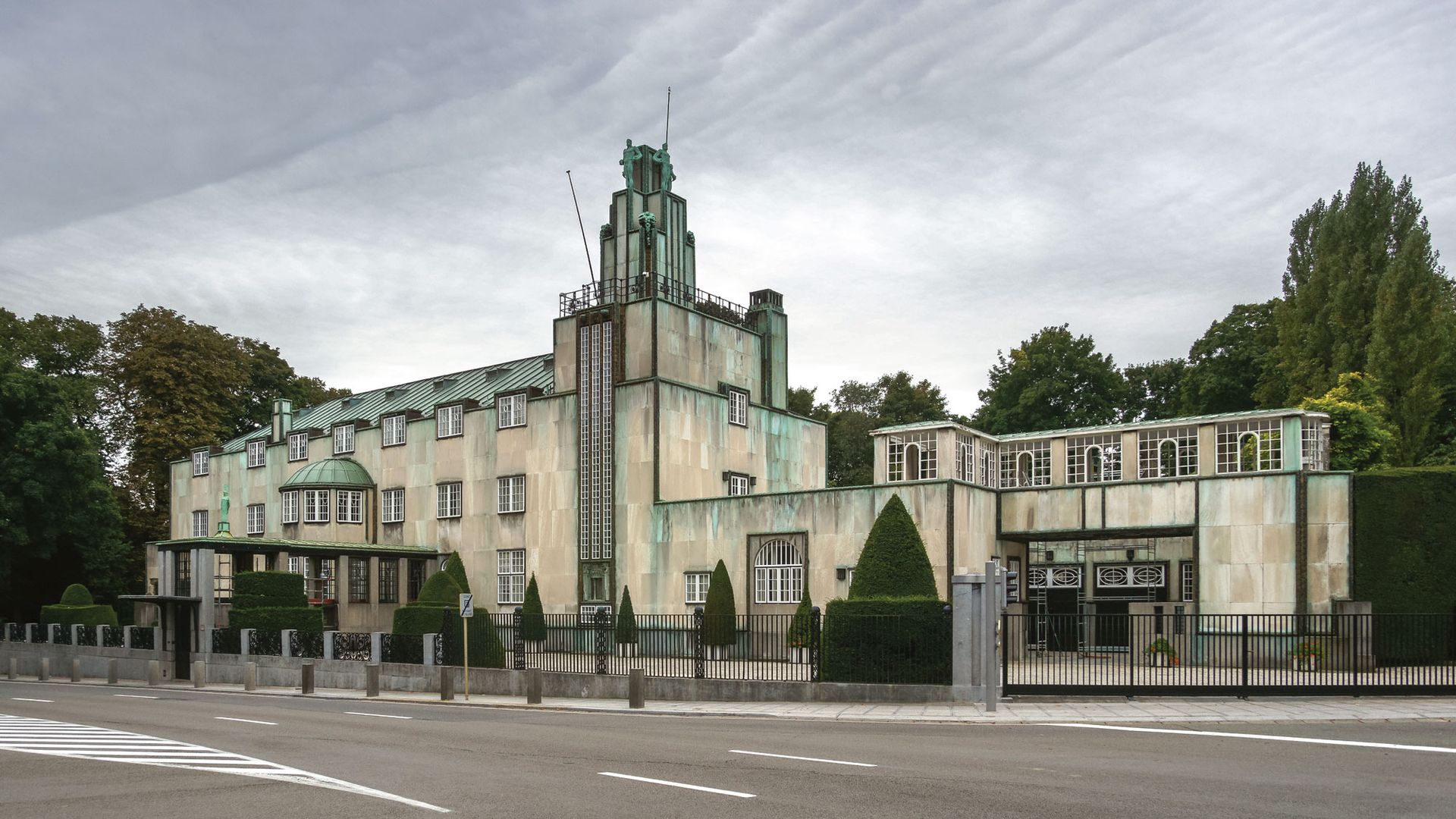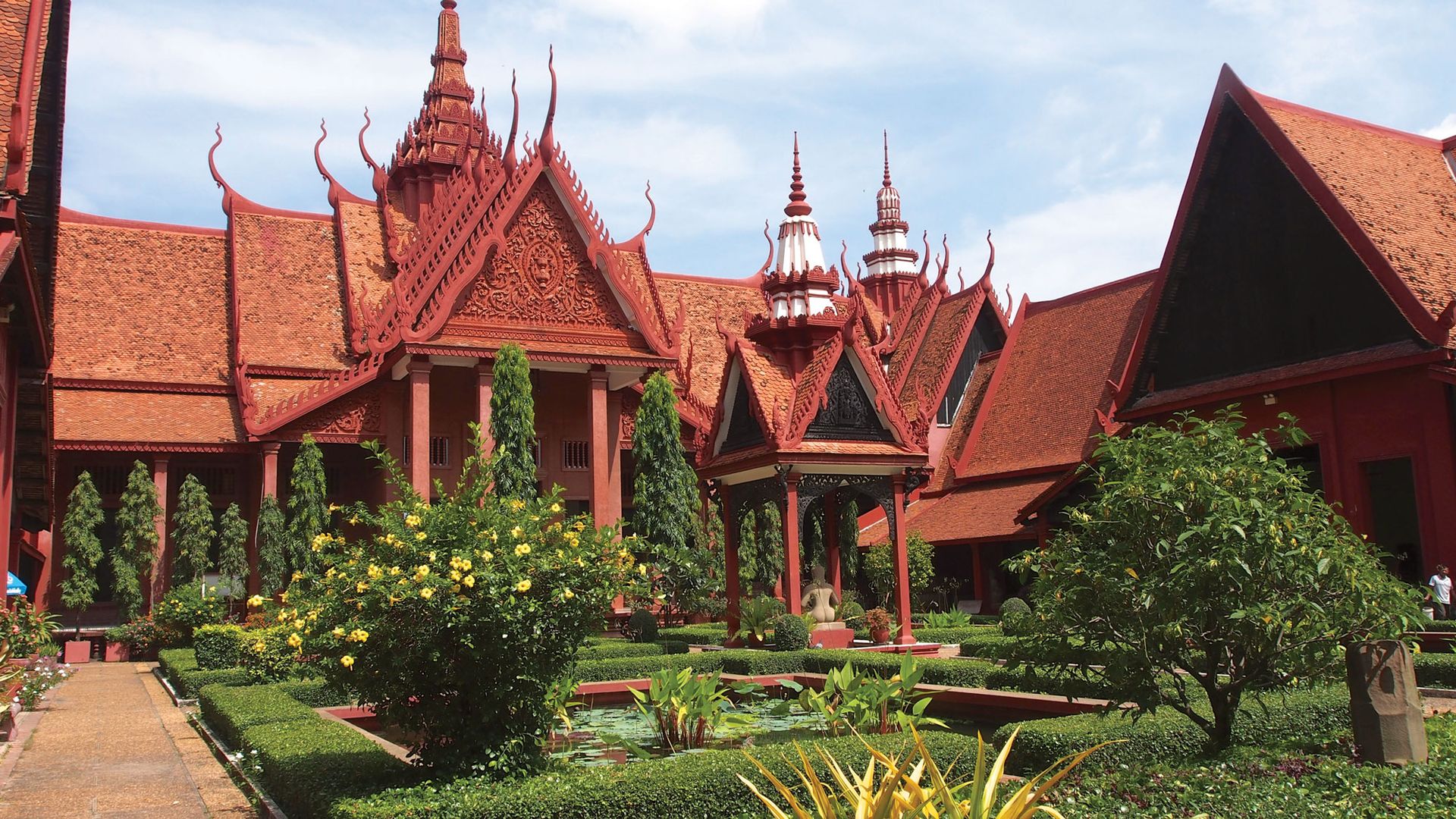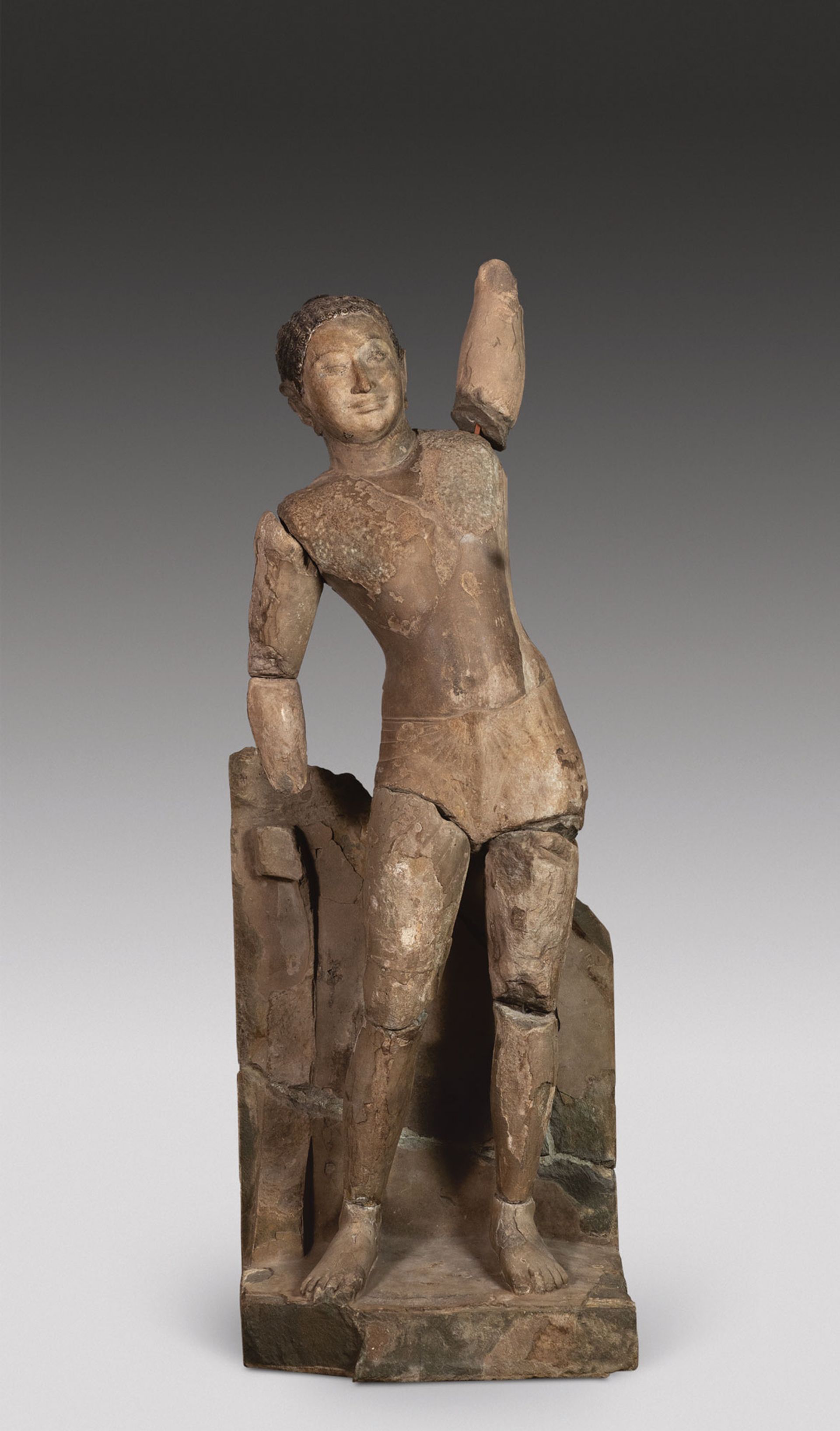For decades, it has been the star of the Indian and Southeast Asian collection at the Cleveland Museum of Art (CMA): a mammoth sandstone statue of the Hindu boy god Krishna, serenely hoisting a mountain to shelter villagers from a deluge of rain unleashed by a vengeful deity.
Carved around AD600 for veneration in a manmade cave at the mountain of Phnom Da in southern Cambodia, Krishna Lifting Mount Govardhan is heralded as one of the first major sculptures in Khmer civilisation, says Sonya Rhie Mace, the museum’s curator of Indian and Southeast Asian art. Acquired by the CMA in 1973, it reflects influences imported from India as well as “an explosion of artistic inspiration and skill” in Cambodia before the centre of creativity shifted to the northwest in the Angkor period, she says.
Yet over the last four years, the Krishna has been radically transformed. Most strikingly, it no longer stands securely on two feet: in a restoration guided by intensive research and the latest scanning and 3D modelling technology, the sculpture has been shorn of a thigh, two calves and feet that had been appended in a painstaking yet evidently misguided 1978-79 reconstruction effort.

Krishna Lifting Mount Govardhan after its recent restoration Photo: courtesy of The Cleveland Museum of Art
Conservators have also added a large upper section showing the figure’s left hand and the top of the stone niche in which the sculpture resided, more fully evoking Krishna’s mythological feat of lifting the mountain. The changes resulted from deep collaboration, including swaps of fragments, with the National Museum of Cambodia in Phnom Penh, which owns another sandstone version of Krishna Lifting Mount Govardhan from Phnom Da and recently finished restoring it.
It’s a co-operation story, it’s a diplomacy story, it’s a conservation story
The detective work that led to the Cleveland sculpture’s transformation and the winding saga of its travels are the focus of a groundbreaking exhibition opening on 14 November at the CMA, Revealing Krishna: Journey to Cambodia’s Sacred Mountain (until 30 January 2022). Amid a soundscape of Buddhist chanting, visitors will experience how long-ago pilgrims travelled along canals in the Mekong River floodplains to worship the sculpture. Donning Microsoft HoloLens 2 goggles, they will then embark on a mixed-reality tour of the Krishna’s 1,500-year history, ultimately entering the cave temple where the sculpture was originally enshrined.

From left: the museum’s statue at the time of its acquisition in 1973; after the 1978–79 restoration; a rendering of a conjectural reconstruction with 3D models of the sandstone pieces; in its present state Cleveland Museum of Art/CMA Archives
The CMA is also physically presenting sculptures of four of the eight deities once ensconced at Phnom Da, thanks to loans from the National Museum of Cambodia and the Musée Guimet in Paris. (The remaining sculptures were too fragile to travel.) All eight are reunited in life-sized interactive 3D projections that allow visitors to rotate the works by 360 degrees and zoom in on details.
Also on loan from Cambodia will be five sculptures from Angkor Borei, the ancient city near Phnom Da that dominated the region and furnished most of its artisans. In the last gallery, a film installation narrated by the actress Angelina Jolie and the writer Loung Ung will present a timeline for the sculptures and underline how international exchange led to the recent restorations and the exhibition.
“It’s a cooperation story, it’s a diplomacy story, it’s a conservation story,” says Mace, who enlisted Jane Alexander, the CMA’s chief digital information officer, to incorporate the mixed-reality experience and other cutting-edge technology into the show. “I love great loans, but we also had to offer people a way to more fully appreciate the works of art and see them in context.”
For William Griswold, the museum’s director and president, the pièce de resistance is the final element of the HoloLens tour that “will restore our Krishna to its original appearance inside the cave temple where it formerly stood”, he says—complete with gold jewellery.
Fragments discarded in a garden
The Krishna’s contemporary history begins around 1910, when the head and torso were unearthed outside the cave at Phnom Da. The sculpture was transported to France, where it was sold in 1920 by the Paris dealer Léonce Rosenberg to the Brussels financier Adolphe Stoclet and his wife, Suzanne. They placed the sculpture on a grand stage in the music hall of their Art Nouveau mansion and called it their “dancing prince”.
After an archaeological excavation, additional sandstone fragments were dispatched to Brussels in 1937 on the assumption that they belonged to the Stoclets’ Krishna. A sculptor living next door agreed to try to attach them, but Stoclet was dissatisfied with the proposed result and the pieces were discarded in the neighbour’s garden.

The Stoclet mansion in Brussels
After the Krishna was sold to the CMA in 1973, its curator Stanislaw Czuma learned of the forgotten fragments and travelled to Brussels to investigate, experiencing a eureka moment when he saw distinctive pleats in the Phnom Da style carved into a sculpted thigh at the edge of a flower bed. With the blessing of the villa’s owners, 17 pieces were dug up from the garden and sent to Cleveland in 1977.
The next year, museum conservators embarked on attaching eight pieces to the torso, giving the impression of a nearly whole figure. In the catalogue for the Sacred Mountain exhibition, today’s conservators write that the pieces were joined then with steel rods set with epoxy into newly drilled holes in the fragments; missing sections of the legs were filled in with epoxy putty and metal casings.
“We have great documentation from that time,” including photographs and notes on each step of the process, says Beth Edelstein, objects conservator at the CMA. The 1970s conservators were harnessing the best techniques available then, but they had no access to the digital scanning technology that is a routine resource for today’s technicians.
It seemed likely that some of the nine unused pieces belonged to the other Phnom Da Krishna, which had entered the collection of the National Museum of Cambodia in 1944. But communication was impossible: from 1975 to 1979, Cambodia was in the grip of the Khmer Rouge, who had closed down the museum and executed many of its staff members. The CMA held on to the pieces until 2005, when Czuma made contact with Cambodian colleagues and arranged for their transfer to Phnom Penh.

The National Museum of Cambodia Photo: Clay Gilliland/Flickr
The two museums became “much, much closer”, Griswold says, as the years passed and the Cambodian museum used those fragments to restore several works. The relationship fully flowered when Mace discovered through dogged research that a sculpture of a monkey god, Hanuman, acquired by the CMA in 1982 had probably been looted from Koh Ker, the tenth-century capital of the Khmer empire.
The museum handed over the work to Phnom Penh in 2015 and signed a memorandum of understanding with the government providing for future cultural exchanges, including loans from Cambodia and a sharing of technical expertise. Renewed last year, the agreement has borne “abundant fruit”, Griswold notes, including a 2017 loan to the CMA of a massive 12th-century bas relief.
But first came the 2015 transfer of a large sandstone fragment that Czuma had returned to Phnom Penh ten years earlier, comprising the left hand and most of the back plate of the Krishna. It had been mistakenly attached to the Phnom Penh version, but 3D scans and digital models revealed that it belonged to the CMA’s sculpture after all.

The National Museum of Cambodia's Phnom Da Krishna sculpture, from which pieces were exchanged with Cleveland's Photo: National Museum of Cambodia
The return triggered an effort to reverse the 1978-79 restoration. Museum workers removed the work from the gallery in November 2017 and brought it to the conservation lab for disassembly. “We were still thinking that the main goal would be to add the upper stela piece and just rearrange the lower pieces,” Edelstein says.
With the aid of 3D models created at Case Western University in Cleveland, however, conservators discovered that once the upper section was aligned properly with the torso, the feet and base “could not line up without forcing the legs to bend too far behind the figure’s centre of gravity”, Edelstein wrote in a recent blog post. That led to a conclusion that two thighs, two calves and a base section with feet had been mistakenly attached to the sculpture in the 1970s.
Measurements and digital models of the two Krishnas were exchanged with the National Museum of Cambodia. The CMA also brought detached parts of its Krishna to the Cleveland Clinic for a CT scan that could shed light on fault lines. Technologies such as 3D modelling and scanning were critical in determining how pieces would fit together, Edelstein says—and digitally manoeuvring the fragments was infinitely easier than moving heavy pieces of stone around.

Krishna Lifting Mount Govardhan being scanned in the Southeast Asian galleries of the Cleveland Museum of Art, 2014 Photo: courtesy of the Cleveland Museum of Art
Communication with colleagues in Phnom Penh and the constant trading of photogrammetry models was pivotal. Finally, researchers realised that the Cleveland Krishna’s right thigh and calf, left calf and base section with feet actually belonged to the Phnom Penh sculpture; they were sent to Cambodia.
The latest restoration involved removing the epoxy and cosmetic fill from the Krishna to ensure easy disassembly in the future. The use of such materials is now frowned upon because the epoxy is difficult to remove and the fill detracts from authenticity. “That’s where they were,” Edelstein says of her 1970s predecessors. “We have so much more information now.”
“Conservation, through its own experiences as a field, has come to realise that we almost never have all the answers,” she adds. For all that the museum team knows, additional fragments from Phnom Da could surface someday.
Now dealing with a top-heavy sculpture, the Cleveland experts worked on lifting the remaining upper section, torso and right thigh—weighing a combined 408kg—with mechanical mounts for inspection. Again and again, they rotated those pieces so that they would align correctly. “We spent hours fitting the two pieces together, pulling them apart, making adjustments,” Edelstein says. (The exhibition’s HoloLens tour “takes visitors through each moment” of the 1937, 1978-79 and 2017-21 restoration efforts, Alexander notes.)
Mace describes the show as a curator’s or conservator’s dream, in how it illustrates the twists and turns of protecting heritage while illuminating the history of a culture. “Things happen to objects over 1,500 years of time,” she says. “What museums are able to do is put the resources towards figuring out what that history was, and sharing it with the world.”
Alexander, meanwhile, suggests that the digital gallery experience, enriched by the large and laboriously transported stone treasures, will set an example. “I’m hoping that it’s a standard for other museums to look at, and to make their collections accessible to all,” she says.
• Revealing Krishna: Journey to Cambodia’s Sacred Mountain, Cleveland Museum of Art, 14 November-30 January 2022


